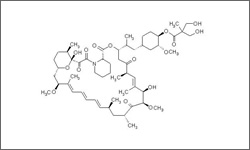Temsirolimus

Temsirolimus (Toricel®) is a kinase inhibitor that prohibits the function of the oncoprotein kinase mTOR, which is a key oncoprotein in the growth of tumor cells. Temsirolimus also inhibits cell division and tumor growth through inhibiting mTOR signaling, which can also lead to apoptosis.1
- 1 Chu, E., & DeVita, V. T. (2015). Physicians' cancer chemotherapy drug manual 2015. Burlington, MA: Jones & Bartlett Learning.
Side Effects include: rash, nausea, weakness/fatigue, Inflammation of mucous membranes, Anorexia, Anemia. Hyerlipidemia and hyperglycemia are also commonly seen in patients, which may require further treatments as a result.1
- 1 Chu, E., & DeVita, V. T. (2015). Physicians' cancer chemotherapy drug manual 2015. Burlington, MA: Jones & Bartlett Learning.
Serious reactions to temsirolimus include: hypersensitivity reactions (flushing, chest pain and/or difficulty breathing), hyperglycemia, interstitial lung disease, elevated serum triglyceride and cholesterol levels, bowel perforation and renal failure. Women should avoid becoming pregnant while on temsirolimus treatment and men undergoing treatment should use barrier methods of contraception. Pregnant women should be advised that there is a potenial harm to the fetus as a result of temsirolimus treatment. Additionally, mothers should discontinue nursing infants during and immediately following treatment. CYP3A inhibitors, CYP3A inducers and St. John's Wort can all interfere with the blood concentration of temsirolimus.1
- 1 Chu, E., & DeVita, V. T. (2015). Physicians' cancer chemotherapy drug manual 2015. Burlington, MA: Jones & Bartlett Learning.
